 |
Feeling lucky?
Want to
search
any of my partnershops yourself
for more, better results?
(commissions earned) |
The links below
will take you
just there!!!
|
|
 |
Joe D'Amato was one of the most prolific genre directors of Italy (back
in the days when the Italians still produced genre movies), yet more often
than not he is dismissed as a sleaze merchant or a studio hack, which is
at least in my eyes a bit unfair. True, his horror films were never on
the same artistic level as those of Mario Bava [Mario
Bava bio - click here] or Dario Argento, he lacked the unique
vision of Lucio Fulci (which, truth to be told, Fulci showed only rarely
as well) [Lucio Fulci bio -
click here], and in terms of craftmanship he was no match for Sergio Martino
or Antonio Margheriti [Antonio
Margheriti-bio - click here]. It's also true that he never saw
filmmaking as an artform but merely as a business venture, that a great
deal of his movies are driven by sensationalism and sleaze, and that he
never shied away from ripping off successful contemporary movies (but for
a time, this was true for most of the Italian film industry). However,
among his vast cinematic output that touches almost every popular genre there
is (including hardcore pornography and extreme gore I feel obliged to
mention) you will find the occasional gem as well as quite a few entertaining
pieces (if sometimes entertaining for all the wrong reasons), some
extremely erotic films ... and, one just has to admit it, lots and lots of
rubbish (sometimes funny rubbish though).
Early Life and
Career
Joe D'Amato was born by the name Aristide Massaccesi in 1936 in Rome,
Italy, to a father who was already working in the Italian film industry
since the early 1930's, usually
as a gaffer since he was a learned electrician - which provided the boy
with an excellent opportunity to enter the business ...
Young Aristide started
following his father's footsteps at the tender age of 14, initially doing
all sorts of menial jobs like cable transporter and set electrician before
rising up in the ranks, and by the late 1950's, he bagan working as an
assistant cameraman, working over the years for quite a number of high
profile directors ranging from Mario Bava (Ercole
al Centro della Terra/Hercules
in the Haunted World, 1961) to Jean-Luc Godard (Le Mépris/Contempt,
1963), from Duccio Tessari (La
Sfinge Sorride Prima di Morire - Stop - Londra/Secret
of the Sphinx, 1964) to Franco Zeffirelli (La Bisbetica Domata/The
Taming of the Shrew, 1967).
By the late 1960's, Aristide Massaccesi - as he then still
called himself - had risen in the ranks to director of photography, and as
such his work can be seen in many a fine and/or notorious genre film like
Massimo Dallamano's Cosa
avete fatto a Solange/What
Have you Done to Solange (1972), Giu
la Testa ... Hombre/Fistful
of Death (1971, Demofilo Fidani), Il
Plenilunio delle Vergini/The
Devil's Wedding Night (1973, Luigi Batzella as Paul Solvay), L'Anticristo/The
Antichrist/Blasphemy (1974, Alberto De Martino), and the
Italian-American co-production The
Arena/La Rivolta delle Gladiatrici
(1974, Steve Carver), a Roger Corman production starring Pam Grier of which
D'Amato is quite frequently given co-director-credits in various sources,
though this claim is unconfirmed.
First
Directorial Efforts Aristide Massaccesi did
direct his first film in 1972, Scansati ... a Trinita Arriva Eldorado/Pokerface/Trinity
in Eldorado, a cheaply and quickly shot Western comedy. However, he
did not sign that film with his own name (or any pseudonym) and instead
had directing credits go to the film's producer Diego Spataro (under his
alias Dick Spitfire). The film was held back until 1975 though and then it
flopped terribly. Aristide Massaccesi also did not sign the films that
immediately followed Trinity in Eldorado as a director with his own
name, the Western Un Bounty Killer a Trinita/A Bounty Killer for
Trinity (1972) went to the film's production manager Oscar Santaniello
aka Oskar Faradine, while Sollazzevoli Storie di Mogli Gaudenti e Mariti
Penitenti - Decameron nº 69/More Sexy Canterbury Tales (1973)
and Fra' Tazio da Velletri (1973) were credited to Massaccesi's own
assistant director Romano Gastaldi aka Romano Scandariato. This was
however not some sort of conspiracy against Massaccesi but rather happened
by his own choice as back in the early 1970's he was still a much-demanded
director of photography and he was fearing that if it came out that he was
moonlighting as a director it could jeopardize his career. As a
consequence, even when he didn't borrow someone else's name for the
directing credits of a film, he rather made up some fantasy name than use
his own name. So Aristide Massaccesi was John Shadow for Canterbury
No 2 - Nuove Storie d'Amore del '300/Tales of Canterbury (1973)
- a film quite obviously inpired by the success of Pier Paolo Pasolini's I
Racconti di Canterbury/The Canterbury Tales (1972) - and he
became Michael Wotruba for the war movie Eroi all'Inferno (1973) -
a film that featured Klaus Kinski in a small role -, the sex comedy Novelle
Licenziose di Vergini Vogliose/Diary of a Roman Virgin (1973)
and the oddity Pugni, Pupe e Karatè (1973) that starred Richard
Harrison [Richard Harrison-bio
- click here]. By and large, these films were all cheaply produced
routine pictures, nothing really memorable and most of them made to cash
in on a current success, but these were the films where D'Amato learned
his craft, whether he's credited or not ...
Actually, Aristide Massaccesi signed only one film he directed ever
with his
real (birth) name, 1973's La
Morte ha Sorriso all'Assassino/Death
Smiled at Murder, mainly because on one hand he was encouraged by
the film's budget that was significantly higher than those of his previous
films, and on the other hand he had the chance of working with Klaus
Kinski (again) and Ewa Aulin, then a popular Italian actress - which made
the film just something he wanted to put his name on. But however proud
Massaccesi was of the film, it comes across as a little bit of a mess, a
wild blend of gothic and erotica, a mixture of ghost story, reanimation of
the dead, and straight, lesbian and incestuous sex, presented in an
over-the-top manner. Now it's of course easy to dismiss Death
Smiled at Murder as simply a bad movie for all its shortcomings
(not only storywise), but to trashfilm fans like me, it has this
irresistible B-movie charm that makes it quite enjoyable.
By
1975, Aristide Massaccesi gave up working on other people's films - as
director of photography or anything else -, with one of his last works
being re-editing Jess Franco's never-released hardcore Marquis
de Sade adaptation Juliette, oddly enough by throwing
out half of the footage shot by Franco and replacing it with scenes from
two other Franco-films, Shining Sex (1975) and Midnight Party/Lady Porno
(1976) to make up a whole new (and different) film, Justine De Sade
- which wasn't released until 1979. Also around 1975, Aristide
Massaccesi adopted a new alias, Joe D'Amato, a name that ultimately stuck
with him for the rest of his career - even if he would time and again
still use yet other pseudonyms as well, David Hills and Steve Benson
readily spring to mind, but there were others still ...
One of the
first films that Massaccesi directed as Joe D'Amato was Emanuelle e
Francoise le Sorelline/Emanuelle's Revenge (1975), a
sexploitation film he co-scripted with Bruno Mattei [Bruno
Mattei bio - click here] with a title that was quite clearly inspired by
the then popular Emmanuelle-series,
but while the Emmanuelle-films
were basically glossy travelogues with sex and some atrociously silly and
pretentious dialogue
tagged on, Joe D'Amato went straight to the jugular with Emanuelle's
Revenge, in which a model (Rosemarie Lindt) is raped by a thug (George
Eastman), but then she gets hold of him, chains him up and has her
revenge - by hiding him away behind a one-way mirror and having sex with
countless partners of both sexes in front of the mirror just to ever
increase his sexual frustrations - now I don't know, aren't there easier
ways to get your revenge ? Maybe, but certainly not sleazier ... (By the
way, despite other claims elsewhere, Emanuelle's Revenge was not,
and wasn't intended to be, a part of the Black
Emanuelle-series which Joe D'Amato took over one year later -
see next paragraph -, it was just an attempt to cash in on the Emmanuelle-series
- as was the Black
Emanuelle-series, incidently - by using the name Emanuelle,
with one m as opposed to the original series, in the title.)
Black
Emanuelle
In
1976 Joe D'Amato had what can be seen as his breakthrough as a director
when he took over the Black
Emanuelle series (which wasn't even a series yet) from Bitto
Albertini - but to properly tell this story, we have to go back to the
year 1975, when Albertini (under the alias Albert Thomas) directed a film
called Emanuelle Nera/Black
Emanuelle, a film that was quite obviously inspired by
above-mentioned Emmanuelle-series,
and not only because of the title - just like the original Emmanuelle
(1974, Just Jaeckin), the film offered exotic locations presented
travelogue style to frame a story about some horny foreigners (foreigners
to the exotic locations) engaging in all sorts of sexual activities, and
while the film is harmless fun to watch and probably more enjoyable than
the whole Emmanuelle-series, it's also completely pointless and quite forgettable ... if it
wasn't for the film's lead actress Laura Gemser [Laura
Gemser-bio - click here] an extremely erotic and exotic
beauty who easily made the film her own. In this respect it is quite
ironic to note that Gemser was chosen for the lead quite probably only
because she had a small (but revealing) role in Emmanuelle,
l'Antivierge/Emmanuelle
2 (1975, Francis Giacobetti). Anyways, for whatever
reason, Albertini did not ask Gemser back for his Black
Emanuelle-sequel Emanuelle Nera No 2/Black Emanuelle 2/New
Black Emanuelle (1976) - he hired Shulamith Lasri aka Sharon Lesley in
her stead - and the film turned out to be a desaster at the box office and
is today as good as forgotten.
Joe D'Amato's Black
Emanuelle-sequel Emanuelle Nera: Orient Reportage/Emanuelle
in Bangkok (1976) on the other hand - which was released a good two
months before Albertini's film - totally revolves around Laura Gemser,
which makes the film almost irresistible. Stylistically, Emanuelle
in Bangkok pretty much follows Black
Emanuelle's lead, once again the film is a blend of erotica and
exotica, of travelogue and sleaze, only D'Amato was clever enough to shift
character motivations around a bit: In this one and the subsequent movies,
Emanuelle is an investigative journalist who has a habit of getting in the
thick of it, and who just happens to be (extremely) promiscuous and tries
to solve all her problems with sex - and usually successfully so. This of
course gives Laura Gemser much more motivation than in the previous Black
Emanuelle-film let alone Sylvia Kristel in the Emmanuelle-series
and thus makes Emanuelle
in Bangkok more interesting - even if the film at the same time was
made on an obviously low budget and focussed first and foremost on sleaze.
D'Amato
followed Emanuelle
in Bangkok with three (!) sequels the very next year: First there
was the rather misleadingly titled Emanuelle
in America (1977) which is in fact nothing short of a sleaze-fest
with an abundance of sex scenes and even some hardcore (without Laura
Gemser performing though) thrown into the mix (at least in the uncut
edition), plus a scene in which a woman gives a horse a handjob. The film
is of a rather episodic structure, with Emanuelle visiting various sex
resorts and sex clinics around the world, with extensive footage
shot in Venice (Venice, Italy not Venice, California, as you can easily
tell), which once more
results in many travelogue style sequences, before she returns to the USA
to expose a snuff ring - which results in a few ghastly scenes for which
D'Amato was accused of having used or even shot real snuff material, but
of course it was all just crude but effective special effects. It's save
to say though that Emanuelle
in America is one of Joe D'Amato's more outrageous films (and
there are many outrageous films to follow) and both concerning sex and
violence it seems to go right to the jugular.
After the over-the-top Emanuelle
in America, D'Amato's next entry into the series, Emanuelle - perché
violenza alle donne ?/Emanuelle around the World
(1977) was a bit of a letdown: Sure it still contained sex aplenty, and
again Joe D'Amato treats his audience to a few isolated scenes of hardcore
sex (again Laura Gemser not performing, even if one scene clumcily
suggests she is), but it's by far not as wild as its predecessor and not
as appealing, even if it does better in the story department, teaming up
Laura Gemser with asidekick, Karin Schubert - who also was in the original
Black
Emanuelle - to smash a white slave ring ... and having many erotic
adventures along the way. Still the story of the film comes across as
awfully episodic - but then again, the general audience might not exactly
watch a Black
Emanuelle-film for its narrative coherence in the first place
...
On a pure narrative level, in fact, Joe D'Amato's third Black
Emanuelle-film for 1977 would be much more satisfying - it's
just wild in other ways and certainly not to everyone's liking ...
In 1977, director Ruggero Deodato [Ruggero
Deodato-bio - click here] had just revived the cannibal genre
with his film Ultimo
Mondo Cannibale/Jungle
Holocaust/Last Cannibal World,
basically a violent adventure movie with heaps of gore starring Massimo
Foschi, Ivan Rassimov and Me Me Lai [Me Me
Lai bio - click here]
- and suddenly cannibal movies were the talk of the day and an immensely
profitable genre for the next few years.
Joe D'Amato was among the very
first to jump the bandwagon with his film Emanuelle
e gli Ultimi Cannibali/Emanuelle
and the Last Cannibals (1977), in which he (with reasonable
success) tried to merge the Black
Emanuelle- with the cannibal-formula - and for that occasion
he also showed what an economic filmmaker he was: While most cannibal
movies of the time were shot on location in the Phillipines, D'Amato just
took his cast and crew to a forest near Rome that was supposed to double
for the Amazonian jungle - and truth to be told, the Italian forest works
reasonably well as the tropics, plus of course, who is concentrating on
trees and plants anyways when Laura Gemser and young Mónica Zanchi get
naked a lot and scenes of gore and dismemberment are around
every other corner ?
As a whole, the film isn't even half bad, a typical
cannibal movie with a rather stupid plot that goes straight to the jugular
in terms of violence - which is of course a trait of the genre as a whole -
and has some sex attached to top it off.
After the excesses of especially Emanuelle
in America and Emanuelle
and the Last Cannibals, La Via della
Prostituzione/Emanuelle and the White Slave Trade/Emanuelle
and the Girls of Madame Claude, D'Amato's 1978 entry into the Black
Emanuelle-series, comes across as rather tame, it's starts out
as another travelogue-sleaze hybrid until Emanuelle decides to smash
another white slave ring - this time by going undercover as a prostitute
and soon becoming the top hooker of a brothel. But while there is no
explicit violence in this film and the sex is decidedly softcore, it's
also one of the most entertaining films of the series. In all,
however, the Black
Emanuelle-series has lost steam and above all audience appeal
over the years, so as early as in 1977, Joe D'Amato co-directed a Mondo-film with Bruno
Mattei [Bruno Mattei bio -
click here] hosted
by Laura Gemser (as Emanuelle), Le Notti Porno nel
Mondo/Sexy Night Report/Mondo Erotico, which was
followed in 1978 by Emanuelle e le Porno Notti nel Mondo 2/Emanuelle
and the Erotic Nights, once again co-directed by D'Amato and Mattei -
both cheesy anthologies of unrelated (softcore) sex scenes taken from
various sources, spliced together rather at random and only so-so held
together by Laura Gemser's introductions and segues. (By the way,
besides these two, D'Amato also made the Mondo films Le Notti
Porno nel Mondo n. 2/Sexy Night Report 2/Scandinavian
Erotica and the Amanda Lear-hosted Follie di Notte/Crazy
Nights, both in 1978.) (And even more by the way, Bruno Mattei tried
to revive the Black
Emanuelle-series in the 1980's with two women in prison films
also starring Laura Gemser, Violenza
in un carcere femminile/
Violence in a Women's Prison/
Emmanuelle in Hell (1982) and Emanuelle
Fugal dal'Inferno/Emanuelle's
Escape from Hell/Women's
Prison Massacre/Blade
Violent (1983) - which were no match for D'Amato's films though.) During his work on the Black
Emanuelle-series, D'Amato only made few other movies, and only
two of them are of interest, actually:
- Eva Nera/Black
Cobra Woman (1976) is an erotic revenge drama starring Laura
Gemser (again) as a high class stripper who does an act with a giant
snake, and Jack Palance as a snake lover who falls for the stripper even
though she is more attracted to a lesbian (Michele Starck) and
Palance's own brother (Gabriele Tinti, Gemser's real life husband) -
until of course the brother kills the lesbian ... Black
Cobra Woman actually could have been a good film, an erotic
murder mystery with horror overtones, if it wasn't for a rather lazy
directorial job, a rather muddled screenplay, and once again many
travelogue-style scenes (this time shot in Hong Kong).
- While Black Cobra Woman
isn't too much unlike your average Black
Emanuelle-film - it had Laura Gemser, exotic backdrops and
sexscenes aplenty - Duri a
Morire/Tough to Kill (1978)
is pretty
much a complete change of pace, a war film about a group of
mercenaries on a manhunt with definite parallels to Sam Peckinpah's
masterpiece Bring me the Head of Alfredo Garcia (1974). What's
really interesting about Tough to Kill
is that for the longest time, it seems to carry a racist subtext,
exemplified in the relationship between hero Luc Merenda and his
manservant Percy Hogan - until in the end, Percy Hogan comes out on
top, having used Merenda's racism against himself. Of course though,
it was far from D'Amato, a director who always had his mind on the
money first, to make a statement of any sorts with his film let alone
a message movie, so the whole parable of racism hitting back in one's own face is
hidden in a trashy, cheaply made warfilm that might not always live up
to the promise of its basic plot ...
The Caribbean Series
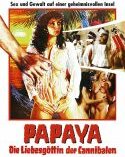
 Flix.com Flix.com
|
| |
In 1978, Joe D'Amato started his Caribbean
series with the film Papaya
dei Caraibi/Papaya
of the Caribbean, a rather weird tale of violence and voodoo, sex
and seduction which is basically about a handfull of natives opposing a
powerplant to be built in their village by seducing and killing the
powerplant's engineers (!).
Actually, the Caribbean
series is not a series as such, but a sextet of films that
were filmed in the Caribbean and - quite in the spirit of Emanuelle
and the Last Cannibals - quite freely mix sex and gore, both often quite
explicit, but while Emanuelle
and the Last Cannibals is besides the sex and violence issue a
pretty straight forward adventure film, the films of the Caribbean
series often feature incredibly delirious plots and incredibly
muddled screenplays. Also, the films
often feature quite similar sets and locations, first and foremost because
they were on one hand shot back to back or on the other incorporated
scenes from each other, plus many performers like Geroge Eastman, Mark
Shannon, Lucia Ramirez, Dirce Funari and Annj Goren turn up in more than
one film. And almost all of the films feature at least some hardcore
scenes if not being hardcore porn as such. In 1980, Papaya
of the Caribbean was followed by Orgasmo
Nero, Hard Sensations, Sesso Nero/Black Sex
and Le
Notti Erotiche dei Morti Viventi/Erotic
Nights of the Living Dead while in 1981 Holocausto
Porno/Porno
Holocaust
followed.
- Orgasmo
Nero has scientist Richard Harrison [Richard Harrison-bio
- click here] give a native girl (Lucia Ramirez) to his wife
(Susan Scott) as a present/slave - but thing is, the native girl and the
wife fall in love with each other, which eventually leads to Harrison
raping the native girl and ultimately to her tribe sacrificing him
while she stays with the wife in happy lesbian bliss. The film
features a few hardcore scenes, most probably pulled from Porno
Holocaust, which wasn't even released until a year later.
- Hard Sensations, the least known of the series, is pretty much
a version of Last House on the Left (1972, Wes Craven) set in
the Caribbean, with three escaped convicts having their way with three
young girls ... until the girls turn the tables.
- Black Sex
has a man (Mark Shannon), who prior to vital
surgery in which his penis will be cut off, wanting to find his one
true love (Annj Goren), whom he had left 10 years ago, to resolve
things with her. Thing is, she is supposed to have died all those
years ago, but when he's not busy shagging other women (like the
series' regular Lucia Ramirez) or feeling pain in his penis, he tends
to see the girl everywhere ... could it be voodoo ?
- Erotic
Nights of the Living Dead features Laura Gemser [Laura
Gemser-bio - click here] as a native seductive priestess
releasing her zombies on those who want to turn her island into a
holiday resort, in particular Mark Shannon, Dirce Funari and George
Eastman. Once again, the film features a few hardcore sex scenes that
seem to have been shot for the movie (and not just interspersed at a
later date as D'Amato later claimed in an interview), but the scenes
with Gemser are all strictly softcore.
- ... and finally there is Porno
Holocaust, perhaps the most notorious film of the Caribbean
series. Essentially it's hardcore porn, but with a
sci-fi-horror plot about a zombie-mutant tagged on, so when the actors
are not busy fucking themselves, they are bumped off by a zombie,
who uses his enormous dick to either smother or shag his female
victims to death (he disposes of the men much more traditionally, by
the way). In the end, it's only series regulars Mark Shannon and Lucia
Ramirez who survive the ordeal. It eludes me (or anyone else for that
matter) why D'Amato thought it to be a good idea to mix hardcore sex
and zombies, but then again, Porno
Holocaust is to a degree entertaining to watch ...
Actually, there was yet another film that Joe D'Amato shot in the
Caribbean during that time, Porno Esotic Love/Porno Exotic Love
(1980), but this is actually little more than a reworking of Black
Cobra Woman, using circa 40 percent of that film all freshly
redubbed and tied together (?) by scenes of Mark Shannon, Dirce Funari and
Annj Goren performing hardcore sex, plus a few Hong Kong location shots
thrown into the mix. Interestingly Jack Palance is in none of the Black
Cobra Woman-footage - and he was probably quite happy to not
be associated with a hardcore film he didn't even act in ...
Joe D'Amato, Horror Director
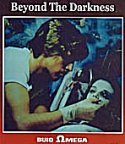
 Flix.com Flix.com
|
| |
| 
 Flix.com Flix.com
|
|
Let's go back in time a little to 1979, when Joe D'Amato found his other
true vocation besides sleaze: Horror.
Sure, many of his erotic features from the 1970's had horror elements,
and Death
Smiled at Murder was even an outright gothic, but it was 1979's Buio
Omega/Beyond the
Darkness/Blue
Holocaust which really brought D'amato to international attention
as a horror filmmaker, because of the film's cynical, disquieting and almost
perverse atmosphere - but mainly because of its gruesome gore scenes.
The film features a weird story about a widowed taxidermist (Kieran
Canter, the weakest element of the film) who can't get over the death of his
wife (Cinzia Monreale), so he digs up her body, embalms it and keeps it in
his French bed - but to keep his secret, he finds himself forced time and
again to kill young women, while his perverted maid (Franca Stoppi)
desperately tries to get him to marry her - until the wife's twin sister
and splitting image shows up ... It all ends in a gruseome fight between
our taxidermist and his maid ...
Actually, Buio
Omega is a pretty effective little shocker, and even if its story
was quite obviously inspired by the little-known and rather disappointing
Italian thriller Il Terzo
Occhio/The
Third Eye (1966, Mino Guerrini) starring Franco Nero [Franco
Nero-bio - click here], it turns out to be the better of
the two films and D'Amato proves that he can handle gore, atmosphere and
suspense equally well.

 Flix.com Flix.com
|
| |
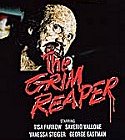
 Flix.com Flix.com
|
| |
Unfortunately, the film gained a certain (very profitable) notoriety on
basis of its rather gruesome gore scenes - D'Amato had a certain talent of
creating crude but effective gore effects on his own simply by buying
props at a local butchery - instead of its other qualities, and as a
result, D'Amato - always more of a businessman than an artist - reacted to
this by making his most notorious, most gruesome but also blaeakest
shocker, Antropophagus/The
Grim Reaper/Man-Eater,
in 1980.
The film is basically about a bunch of tourists arriving at an island
paradise - only to find it completely deserted safe for one man (George
Eastman) who is a demented mutant who feeds preferably on human flesh -
and since he has already eaten all of the island's inhabitants he
starts to feed on our tourist group ...
The film has gained widespread notoriety especially for one scene in
which George Eastman rips the fetus (actually a skinned rabbit) from a
dead woman and eats it up, a very unsettling scene but exactly the kind of
stuff an otherwise rather dull film like this needs to create a scandal, become infamous and
remain memorable - besides granting the film many re-releases ... and this
way, with one of his weaker films, Joe D'Amato had one of his biggest
successes ...
The 1981-film Rosso
Sangue/Absurd
was marketed as a follow up to Antropophagus,
even though the films have little to do with each other (safe for George
Eastman as the mad baddie in both of them) and actually Absurd
wasn't even intended to be a sequel to the earlier film, and references to
Antropophagus
were only added during shooting after that film became such an unexpected
success. Absurd
however lacked Antropophagus'
bleakness as well as its gory setpieces and thus couldn't duplicate the
success of the earlier film by a long shot and is today almost forgotten.
... which is a shame really since in direct comparison, Absurd
is the far better film, a little suspense tale about demented George
Eastman terrorizing a small American village. Sure, the film is a bit
short on plot and isn't always completely plausible, but rather
unexpectedly Joe D'Amato proves his talent creatng suspense, and as a result he has
directed a very tense and exciting little
thriller - just too bad he has made the movie in a time when everyone was
longing for gore ...
Rip-offs
Once again let's go back in time for a bit, and once again to the late
1970's: By this time, the Hollywood blockbuster was beginning to take over
the cinematic world, and because of smaller budgets and smaller
advertising budgets compared to US-movies, the Italian film industry found
it more and more difficult to compete, but what's worse, it also lost
confidence in its own strength, and from the late 1970's onwards, many
Italian genre movies were mere rip offs of (mainly American) hit movies.
Joe D'Amato, who was always a money-conscious filmmaker (both
concerning keeping his budgets low and keeping his profits high) never had
a problem with copying other people's concepts, as he has proven with some
of his previous films like the Black
Emanuelle-series - an obvious take on the Emmanuelle-series
- and Emanuelle
and the Last Cannibals - which was quite clearly inspired by Jungle
Holocaust - and thus he had little reservations about making
rip-offs of other popular films:
- Immagini di un Convento/Images in a Convent (1979)
followed hot on the heels of Walerican Borowczyk's Interno di un
Convento/Behind Convent Walls (1978), but of course with
that film's power. Still, the film, D'Amato's first excursion into
nunsploitation - a genre he would revisit with La
Monaca del Peccato/Convent
of Sinners in 1986 - was sleazy as could be, with a hardcore
gangrape scene and plenty of dildo play.
- Erotic
Nights of the Living Dead was of course inspired by the success
of both Dawn of the
Dead/Zombie
(1978, George A.Romero) and Zombi
2/Zombie Flesh
Eaters (1979, Lucio Fulci), but with sex tagged on.
| 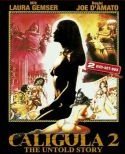
 Flix.com Flix.com
|
|
| 
 Flix.com Flix.com
|
|
- Caligola: La Storia mai Raccontata/Caligula: The Untold Story (1982)
was a quite obvious take on Tinto Brass' highly controversial but
much talked about Caligola/Caligula from 1979, but
to top that film, D'Amato included not only a bit of hardcore sex in
his movie but also a scene of horse masturbation similar to the one in Emanuelle
in America. The result is of course sleaze galore.
- Anno 2020 - I Gladiatori del Futuro/2020 - Texas
Gladiators (1982) and Endgame - Bronx lotta Finale/Endgame
(1983) are both post-apocalyptic sci-fi action movies heavily inspired
by Mad Max 2: The Road Warrior (1981, George Miller). Al Cliver
plays the lead in both of these films, trashy but not entirely
uncharming low budget rip-offs, and both were co-scripted by George Eastman, who
also stars as a baddie in the latter, which also stars Laura Gemser.
- Ator
l'Invincibile/Ator
the Fighting Eagle (1982) and Ator
l'Invincibile 2/Ator
the Blade Master (1984) were both very cheap rip-offs of Conan
the Barbarian (1982, John Milius), the film that made Arnold
Schwarzenegger a star. Unfortunately the Ator-films
starred Miles O'Keefe and were obviously made on the cheap so they're
at best so-bad-they're-good or just utterly ridiculous (depends on your
definition of at best I suppose).
- 11 Giorni, 11
Notti/11
Days 11 Nights (1986) was made in the wake of the then
incredibly successful (but grossly overrated) 9 1/2 Weeks
(1986, Adrian Lyne) - but more about 11
Days 11 Nights below ...
- In 1989, D'Amato made the film Sangue negli Abissi/Squali/Deep
Blood, which was pretty much his version of Jaws (1975,
Steven Spielberg). Interestingly enough, in the 1980's, many Italian
genre directors made Jaws rip-offs, e.g. Enzo G.Castellari's L'Ultimo
Squalo/The
Last Shark (1981) [Enzo
G.Castellari bio - click here] or Lamberto Bava's Shark: Rosso
nell'Oceano/Devil Fish/Monster Shark (1984). By the
way, most of the shark footage D'Amato used in his film is stock
footage he bought from National Geographic.
- In the early 1990's, an erotic film from Hong Kong, Michael Mak's Sex
and Zen (1991) became an international hit (international
hit at least by Hong Kong standards), so Joe D'Amato wasted no
time to travel to the Philippines to shoot a few erotic films with
mostly Oriental actors under the aliases Chang Lee Sun - Kamasutra
Cinese/Chinese
Kamasutra (1993) - and Robert Yip - Racconti della Camera
Rossa (1993) and Cina e Sesso/China and Sex (1994).
- Plus, when D'Amato returned to hardcore porn in the mid-1990's, he
made hardcore versions of many a current blockbuster - but that has to
do more with the genre as such than with the director's predilections
and shall be discussed below ...
First Porn Period in the Early
1980's
As mentioned above, D'Amato was always more businessman than artist, so
when hardcore pornography became a profitable business in the early
1980's, he had no problems trying his hands on that genre as well (and was
actually quite successful at it). This move was of course hardly
surprising since his earlier films also sometimes contained a few hardcore
scenes (e.g. Emanuelle
in America and Emanuelle around the World)
and were often incredibly sleazy even in their softcore sequences, and
thus going into hardcore full swing seemed like the next logical step.
Super Climax (1980), which D'Amato co-directed with Claudio Bernabei -
both of them sharing the alias Alexandre Borsky - was possibly
D'Amato's first hardcore film (it's hard to tell in this genre), and
before long many more followed like Blue Erotic Climax (1980), La
Voglia/Desire (1981) Bocca Golosa/Greedy Mouth
(1981), Caldo Profumo di Vergine (all 1981), and Super
Hard Love (1982), all also co-directed with
Claudio Bernabei, above mentioned Porno
Holocaust, Orgasmo Esotico (1982) - another porn-zombie
hybrid, this time co-directed with Mario Siciliano -, the hardcore peplums
Messalina Orgasmo Imperiale (1983) and Una Vergine per l'Impero
Romano (1983), and Le Déchaînement Pervers de Manuela/Unleashed
Perversions of Emanuelle/Emanuelle's Perverse Outburst (1983),
a film that mixes scenes from various films of the Black
Emanuelle-series and from Black
Cobra Woman with hardcore scenes from Porno Exotic Love
to elevate (?) the Black
Emanuelle-series to hardcore level ... oh well.
The Mid-1980's to Mid-1990's: The
Softcore Period
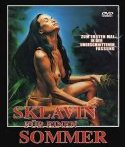
 Flix.com Flix.com
|
| |
In the mid-1980's, Joe D'Amato gave up hardcore again and returned to
softcore erotica, something he scarcely touched during his hardcore
period, one notable example being Paradiso Blu/Blue Paradise
(1980), a film starring Anna Bergman, daughter of arthouse legend Ingmar
Bergman. In an attempt to widen the film's appeal and to set it - being
more of a tender love story - apart from his usual sleazy output, D'Amato also
had Anna Bergman sign as directo. The attempt however failed and Blue
Paradise is one of D'Amato's more obscure films.
D'Amato's softcore films from the mid-1980's onwards however somehow
rarely matched those of the 1970's. Initially, everything still seemed to
be in the right place, and a film like L'Alcova/The
Alcove/Lust
(1984) starring Laura Gemser [Laura
Gemser-bio - click here], Al Cliver, Lilli Carati and Annie
Belle is still sleazy enough to compete with the best of them. Soon
however, his films deteriorated to meaningless and mindless drivel.
The main problem was probably that most of his later films lacked a
lead actress with the beauty, the enthusiasm and the charisma of Laura
Gemser, who being in her mid-30's, was getting a bit old for this kind of
work (she still stayed with D'Amato, with whom she was close friends,
though as a supporting actress, extra and later costume designer), and a
suitable substitute was hard to be found.
The only actress who somehow came close to replacing Gemser was Italian
model-turned-actress Jessica Moore (born Luciana Ottaviani) [Jessica
Moore-bio - click here], a very sensual, curvey and
self-confident young woman whom D'Amato discovered in 1986, when she was a
mere 19 years old.
D'Amato quickly cast Moore in two of his films in 1986, the
nunsploitation film La Monaca del
Peccato/The
Convent of Sinners and 11 Giorni, 11
Notti/11
Days, 11 Nights, a 9 1/2 Weeks rip-off. In The
Convent of Sinners, Moore only played a supporting part and was
given no opportunity to really shine, but in 11
Days, 11 Nights she plays the lead, a promiscuous writer doing
field research for her erotic novels (and you know what that means) - and
she quite simply melts the screen. Consequently, the film became one of
D'Amato's biggest international successes, even if it's not one of his
better directorial efforts and features a rather silly storyline.
In 1988, D'Amato made a sequel to the film, Top
Model/11 Days, 11 Nights Part 2,
once again starring Jessica Moore as the lead character, Sarah
Asproon, and if anything she's even hotter in this one and
again carries the film's silly plot effortlessly.
However, when in 1990 Joe D'Amato asked Jessica
Moore back for his third Sarah
Asproon-film Undici Giorni, Undici Notti 2/Web of
Desire he had to find out she had already retired from the screen due to her overly
jealous fiancé (and later husband), and eventually D'Amato made the film with little-known Kristine Rose. She however failed to
create a lasting impression similar to that of Jessica Moore, and since
the film was not nearly as successful as its predecessors, the
series was disbanded afterwards ...
D'Amato tried out quite a few actresses from the mid-1980's onwards but
none managed to make a lasting impression, and some even were appaling:
There was Lilli Carati, Miss Italy 1975, who was in above-mentioned The
Alcove, and Il Piacere/The Pleasure (1985), Voglia
di Guardere/Midnight Gigolo and Lussuria/Lust
(both 1986), American actress Tara Buckman was in Blue Angel Café
(1989) and La Signora
di Wall Street/High Finance Woman
(1991), and Valentine Demy was in the
weird but bad sex-voodoo tale Pomeriggio
Caldo/Afternoon
(1987) as well as Amore Sporco/Dirty Love (1988) - Demy would
by the way soon
graduated to Tinto Brass films (Snack Bar Budapest [1988] and Paprika
[1991]), even if she never got beyond supporting role status.
In the early 1990's, D'Amato started to put more and more effort into
his softcore flicks to give them a better and more expensive look,
however, the better-looking they were the more blatant and forgettable
they were as well, and with badly scripted films like Kamasutra
Cinese/Chinese
Kamasutra and Il Labirinto dei Sensi/Labyrinth of
Love (both 1993) he failed to leave any impression at all - quite unlike
the erotic films from his early career.
During the late 1980's/early 90's, D'Amato also tried to make a few
films away from the erotic genre, but unfortunately these films were not
too impressive either:
- Above mentioned Sangue negli Abissi/Squali/Deep
Blood (1989) was little more than a cheap and disappopointing Jaws-rip-off.
- Quest for the Mighty Sword/Ator l'Invincibile/Ator
III: The Hobgoblin (1990) is a film of the so-bad-it's-good
variety, a totally over-the-top but under-budgeted fantasy film not
really connected to the first two Ator-films
(and starring a different lead actor, Eric Allan Kramer). Actually
this film is so wild concerning blending far out story elements with
cheap special effects it has to be seen to be believed.
- Contamination .7/The Crawlers (1990) is a weird little
film about radioactive tree roots killing people after nuclear waste
has been illegally dumped in a forest. But like Quest for the
Mighty Sword, the budget was way too low to provide proper special
effects for a story like this.
- Finally there was Ritorno
dalla Morte/Return
from Death/Frankenstein
2000 from 1992, which was widely advertised as Joe D'Amato's
return to the horror genre (even though he signed it as David Hills)
- but the film about a woman in a coma (Cinzia Monreale) resurrecting
the dead to have vengeance on those who have wronged her turned out to
be a complete desaster, a dull and unconvincing horror-by-the-numbers
without the slightest of scares - let alone even traces of
originality.
By and large, all of this shows how Joe D'Amato's career as a filmmaker
has come to a dead end and consequently, the only logical path for him led
back to hardcore pornography - but more about that later.
Joe D'Amato, Producer
Back in 1980, D'Amato formed the production company Filmirage,
which produced most of D'Amato's (non hardcore) films from then on (the Caribbean
series being a notable exception), its inaugural film being
the notorious Antropophagus. It was in 1987 that D'Amato widened the scope of
the company and besides his own films also produced films by other
directors - many Italian (trash-)horror greats among them -, films that
occasionally have become far more successful and memorable than Damato's own
films from the period:
| 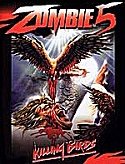
 Flix.com Flix.com
|
|
| 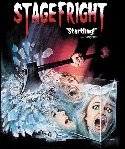
 Flix.com Flix.com
|
|
- Deliria/Stage Fright (1987) was the directorial debut by
Michele Soavi, who soon enough would become one of Italy's horror
greats before leaving the genre behind him and going into other kinds of
film. Stage Fright
is not essentially a great movie, more of your typical slasher
actually, but it's extremely well-made and shows a director with great
talent - as Soavi's future would prove.
- Killing Birds - Uccelli Assassini/Raptors
(1987) was originally to be directed by Michele Soavi as well, but
then he got the offer from Dario Argento to direct La
Chiesa/The Church
(1988), and D'Amato, not wanting to stand in the way of the young talent's
career, let him go and instead hired Claudio Lattanzi to direct
the acting scenes of the film while D'Amato himself handled the
special effects scenes. The result though is a tired zombie film with
killing birds thrown into the mix. Robert Vaughn stars in this one
| 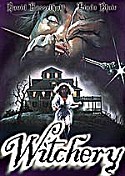
 Flix.com Flix.com
|
|
| 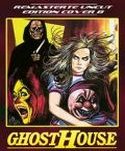
 Flix.com Flix.com
|
|
- Veteran genre director Umberto Lenzi directed La
Casa 3/Ghosthouse
(1988) and Paura nel Buio/Hitcher in the Dark (1989) for
Filmirage
- both not among the better films in his decidedly uneven film career [Umberto
Lenzi bio - click here].
- Ghosthouse did
actually get a sequel, La Casa 4/Witchery/Witchcraft/Ghosthouse
2 (1988, Fabrizio Laurenti) that features a (relatively) stellar
cast including David Hasselhoff, fresh from his success with Knight
Rider and still a year away from Baywatch, Linda
Blair, still trying to live up to her Exorcist
(1973, William Friedkin) reputation, and German veteran
Hildegard Knef.
- Claudio Fragasso's La Casa 5/Beyond Darkness/House
5 (1990) however does not feature the same stellar cast as its
predecessor and is a pretty lame and forgettable film (not that the
earlier films weren't).
| 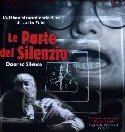
 Flix.com Flix.com
|
|
- Claudio Fragasso also directed Troll 2 (1990), an equally
forgettable film, even if many regard it as a cult item of the
so-bad-it's-good-variety.
- Metamorphosis (1990) was George Eastman's (aka Luigi
Montefiori) first and so far only film as a director. Eastman acted in
many of D'Amato's films and also scripted a few. His main claim to
fame though might be the screenplay for Enzo G.Castellari's cult
Western Keoma (1976).
- Even genre veteran Lucio Fulci [Lucio
Fulci bio - click here] made a film for Filmirage,
Porte del Silenzio/Door to Silence (1991), which would
turn out to be his very last film (he also died in 1991), a weird and
surreal little film that doesn't resemble Fulci's usual output of his
later life and is more Twilight
Zone blown up to feature proportions - not without
interest though.
With the Italian film industry in its death throes in the early 1990's
though, D'Amato eventually shut down the operations of Filmirage
in 1994 and picked up directing hardcore porn full-time, something which
he was already experienced in from his porn stint in the early 1980's, and
since the early 1990's he had done porn on and off ...
Joe D'Amato, Porn Director
With the market for his usual cinematic output pretty much gone, either
retirement or the turn to porn was inevitable, and D'Amato, though
approaching 60, had no desire to retire, plus he was always a businessman
first and artist second (and a sleaze merchant anyways), so he had little
difficulties to cross the boundaries to hardcore porn (again) ...
Within the hardcore-genre, plot-based period pieces were his specialty,
and his films were about actual historical characters - e.g. Marquis de
Sade (1994) and Marco
Polo, la Storia mai Raccontata/Marco
Polo (1995), both starring Italian porn superstar Rocco Siffredi
in the lead and co-directed by Luca Damiano (= Franco Lo Cascio), new takes
on both Caligula
(Caligola: Follia del Potere/Caligula, the Deviant Emperor
[1997, starring Olivia del Rio and Ursula Moore]) and Messalina
(Messalina [1996, starring German porn star Kelly Trump and Olivia
del Rio]), Amadeus Mozart (1995, starring Deborah Wells and Kelly
Trump) and Rudy/Rudolph Valentino, American Lover (1997) -,
characters from Greek mythology - e.g. Aventuras Sexuals de Ulysses/Ulysses
(1998) and Le Fatiche Erotiche di Ercole/The Sexual Challenges
of Hercules (released way after D'Amato's death in 2005, again
starring Kelly Trump) -, plus characters from high and low literature
including Shakespeare-adaptations - Giulietta e Romeo/Juliet
and Romeo (1996) and Hamlet (1997) -, Robin Hood: Thief of
Wives (1996), Carmen (1996, co-directed by Justin Sterling, starring
Ursula Moore), The Erotic Adventures of Aladdin X (1995,
co-directed by Luca Damiano and starring Tabatha Cash), his takes on the Tarzan-myth
- Jungle Heat/Tarzan X (1994) and its sequel Tarzhard,
both starring Rocco Siffredi - and a Jekyll
and Hyde-adaptation once more starring Rocco Siffredi, Dr.
Rocco et M. Sodo (1995), to name but a few. Besides that D'Amato also
made the occasional Western - Rocco e i Magnifici 7/Outlaws
(1998), and its sequel Rocco e i Mercenari/Outlaws 2 (1999),
both starring you guessed it, Mr Siffredi again, and Calamity Jane
(1999), also starring Siffredi - and swashbuckler - I Predatori della
Verginita Perduta/Raiders and Anita
e la Maschera di Ferro/Lady
in the Iron Mask (both 1998, starring Anita Blond). Plus there are
two flicks that fit neither above category really (apart from being
hardcore porn like all the rest) but that are mentioned repeatedly, this
being Passion in Venice (1995, co-directed with Cameron Grant)
starring Juli Ashton, Kelly Trump, Deborah Wells and Anita Blond and Torero
(1999) starring Rocco Siffredi, Sunset Thomas and Olivia del Rio.
I may have to make it clear here that I have rather randomly picked only very few of
D'Amato's porn flicks here, he made about a hundred at the tail end of his
career. Interestingly, in the latter half of the 1990's, D'Amato only made
one none-porn flick, the pirate adventure I Predatori delle
Antille/Predators
of the Antilles/Tortuga
(1999), which he signed with his familiar David Hills-alias.
However, he probably made this film only because he had paid a lot of
money for the stock footage and costumes he used for his pirate/period porns
like Raiders and Lady
in the Iron Mask (both also from 1998) and wanted to stretch the
footage to the max ...
Interestingly enough, D'Amato found the recognition in the porn
industry he never got in the mainstream industry (mainstream as in
non-porn), and looking at his
films, they really look carefully produced and directed, feature some of
the biggest names in the business and obviously were done on a higher
budget than your usual hardcore flick, as reflected in the sets and
costumes - plus D'Amato's insistence on
shooting on film instead of on video quite obviously pays off on a visual
level, his films have a cinematic feel to it rarely found in the genre ...
The downside to it is of course that D'Amato lacks a certain
inventiveness as director, especially his hardcore scenes seem to be just
filmed by the numbers, and at times the plots of his films are so thin
that one wonders why he even bothers to put his performers into costumes
in the first place instead of just letting them have sex. Sure, a film
like Marco
Polo has its amusing moments, but films like Ulysses or Messalina
show the characters just put on their costumes to get from one scene to
the next to take them off again and have sex, with little narrative drive
and no panache at
all.
Closing Words
Joe D'Amato is no more, he died in 1999 from a heart
attack at the age of 62. Besides an extremely rich oeuvre of almost 200
films (many of them hardcore porn), he also left behind a son, who has
followed his father's footsteps and has become a cinematographer and
especially steadicam operator himself, and in that field he has surpassed
his father, working on many prestigious productions and blockbusters
including Gangs of New York (2002, Martin Scorsese), Cold
Mountain (2003, Anthony Minghella), Munich (2005, Steven
Spielberg) and Silent Hill (2006, Christophe Gans). And wouldn't
you know it, he did start his professional career working as assistant
cameraman for his father from the late 1970's onwards.
Admittedly, Joe D'Amato was not the greatest director,
which he never claimed to be, and sometimes it was painfully obvious in
his films that he was more of a businessman than an artist, nevertheless
his films have helped to make Eurotrash the exciting and sometimes hilarious genre it is
seen as today, and it is hardly
surprising that so many of his films, the good and bad alike, are
continually reissued throughout the world. The world quite simply put
would be a sadder and duller place without the trash he made ...
|